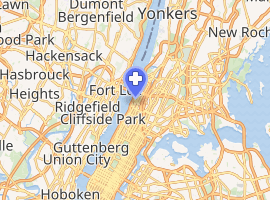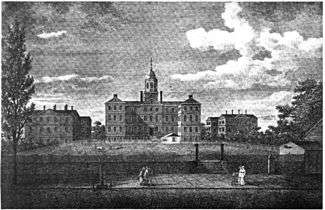New York Hospital
New York Hospital, also known as Old New York Hospital or City Hospital, was founded in 1771 with a charter from King George III, and is the second oldest hospital in Manhattan, New York City, and the third oldest in the United States. It was originally located on Broadway between Duane Street and Anthony Street (now Worth Street).[1][2] In 1998 it merged with Presbyterian Hospital to form NewYork–Presbyterian Hospital.
| New York Hospital | |
|---|---|
_pg470_NEW-YORK_HOSPITAL%2C_WEST_15TH_STREET%2C_NEAR_FIFTH_AVENUE.jpg) The West 15th Street facade of the hospital's second building. | |

| |
| Geography | |
| Location | Manhattan, New York, United States |
| Coordinates | 40.8413°N 73.9428°W |
| Organization | |
| Affiliated university | Cornell University Medical College |
| History | |
| Opened | 1771 |
| Closed | 1998 merged with Presbyterian Hospital to form NewYork–Presbyterian Hospital |
| Links | |
| Lists | Hospitals in New York |
| Other links | Hospitals in Manhattan |


History
The origin of the New York Hospital can be traced to the commencement address of Dr. Samuel Bard, a graduate of the University of Edinburgh Medical School, Professor of the “Practice of Medicine”, delivered to the first two medical doctors to graduate from King’s College, now Columbia University College of Physicians and Surgeons, in 1769 titled “A discourse upon the duties of a physician, with some sentiments on the usefulness and necessity of a public hospital.” Apparently city leaders also listening to this address were impressed enough to pledge one thousand pounds sterling.[3]
Dr. Peter Middleton reported on the progress with furthering this idea in another address to King’s College on November 3, 1769, stating “the necessity and usefulness of a public infirmary has so warmly and pathetically set forth in a discourse delivered by Dr. Samuel Bard… that his Excellency, Sir Henry Moore immediately set on foot a subscription for that purpose to which himself and most of the gentlemen present liberally contributed.” [4] Soon thereafter, the new Governor of the Colony, John Murray, 4th Earl of Dunmore through the interposition of Lieutenant Governor Cadwallader Colden ” started a fund for the establishment of such a hospital.[5]
On June 13, 1771, King George III of England granted a royal charter to establish "The Society of the New York Hospital in the City of New York in America" and a Board of Governors for the "reception of such patients as require medical treatment, chirurgical management and maniacs."[6] The first regular meeting of the Governors after its organization was held on July 24, 1771 at Bolton’s Tavern, the same location where General Washington would bid farewell to his officers on December 4, 1783.[7]
Attending the first meeting were John Watts, President, as well as Philip Livingston and Gerardus William Beekman.[8] The Governors purchased 5 acres (2.0 ha) (a part of the Rutgers farm) in 1771,on elevated ground surrounded at the time on three sides by marshes.[7] The location was several miles from the central part of New York; apparently the expansion of the city and the drainage of the marshes, which harbored malaria, was anticipated.
A building was begun in 1773 but was destroyed by fire before its completion. The American Revolutionary War delayed the work of reconstruction but apparently a partial structure on Broadway and Duane Street served as a barracks for Hessian and British soldiers, as a laboratory for teaching anatomy to medical students, and as a military hospital.[9] Although initially ignored by the wider community, grave-robbing incidences in the 1780s became the subject of public outrage when the medical students carrying out these acts in order to dissect them for anatomical practice turned from stealing from the New York African Burial Ground to the nearby Trinity Churchyard. The raid on the university, attack on the student perpetrators, and the riot that followed have come to be called The Doctor's Riot of 1788.[10]
The hospital was not opened until January 3, 1791.[11] The small two-storied H-shaped building was located along the west side of Broadway between present day Worth and Duane streets, set back from the street frontage about 90 feet to allow for landscaping and expansion[12] The hospital’s first patients were suffering from smallpox, syphilis and acute bipolar disorder. In 1798, the Governors announced that the Hospital was primarily for the purpose of medical treatment, secondly for surgical treatment and thirdly for treatment of “maniacs” (a fourth listed purpose was for “lying-in” woman, post-partum treatment of women) .[7]
1800s expansion
_(14589383660).jpg)
After some years of experience with the mentally ill and the particular challenges of their treatment, the Board of Governors decided to construct an additional building which would specialize in their care. After receiving financial assistance from the Legislature of New York State, they erected "a substantial and spacious stone edifice on the grounds of the hospital in the city, within the same enclosure, and but a few rods distant from the original building. It was finished and opened on the 15 July 1808. On the same day, 19 patients were removed to it from wards in other buildings and forty-eight were admitted. The new department was called the Lunatic Asylum. In June, 1821, patients were transferred to the new Bloomingdale Asylum for the Insane."[13]
In 1821, the hospital opened the Bloomingdale Insane Asylum on Broadway and West 116th Street in Morningside Heights. Due to real estate pressures, it moved to White Plains, New York in 1891,[14] where it eventually became the Payne Whitney Psychiatric Clinic, now known as "New York-Presbyterian/Westchester". The Morningside Heights site became part of Columbia University.[14]
New York Hospital outgrew its original building by the 1870s, and moved to a new building between Fifth and Sixth Avenues and West 15th and 16th Streets, which opened in 1877. The original facility was maintained as a 'house of relief', which moved to Hudson Street in 1884.[1]
Affiliation with Cornell University
In 1912, New York Hospital became affiliated with the Cornell University Medical College and moved in 1932 to a joint facility, the New York Hospital-Cornell Medical Center, now the Weill Cornell Medical Center, on York Avenue between East 67th and 68th Streets. In 1998 it administratively merged with Presbyterian Hospital to become NewYork–Presbyterian Hospital (NYP) and the site functions as one of the six campuses of NYP.[1]
See also
- 1788 Doctors' riot
- List of the oldest hospitals in the United States
References
- Lerner, Adele A. "New York Hospital" in Jackson, Kenneth T., ed. (2010). The Encyclopedia of New York City (2nd ed.). New Haven: Yale University Press. p. 920. ISBN 978-0-300-11465-2.
- "City of New York Extending Northward to Fiftieth St". M. Dripps. Retrieved May 16, 2017.
- "Dr. Bard's Dream". New York Times. May 17, 1971. Retrieved January 20, 2014.
- Earle, Pliny, History, Description, and Statistics of the Bloomingdale Asylum for the Insane, Egbert, Hovey and King, Printers, New York, 1843.
- "Old New York Hospital. Its Interesting History Retraced by Dr. D. B. St. John Roosa. Episode Of The Doctors Mob. The Aftermath of a Fourth of July Celebration. Forty Years Ago. Surgery Then and Now". New York Times. February 11, 1900. Retrieved January 20, 2014.
- Bailey, Harriet (1920). Nursing Mental Disease. New York: The Macmillan Company. p. 27.
- Stone, William L. (1872). History of New York City from the Discovery to the Present Day. New York: Virtue and Yorston. p. 231.
- Old New York Hospital, The New York Times, February 11, 1900.
- Kobbe, Gustav (1891). New York and its Environs. Franklin Square, New York: Harper and Brothers. p. 173.
- Blakey, M. L. (1998). The New York African Burial Ground Project: An Examination of Enslaved Lives, A Construction of Ancestral Ties. Transforming Anthropology, 7(1), 53–58.
- Hurd, Henry, ed. (1916). The Institutional Care of the Insane in the United States and Canada. III. Baltimore: The Johns Hopkins Press. p. 111.
- New York-Presbyterian Hospital/ Weill Cornell Medical Center , retrieved March 28, 2011.
- Earle, Pliny (1843) History, Description, and Statistics of the Bloomingdale Asylum for the Insane, New York: Egbert, Hovey and King. p 9.
- Grob, Gerald N. "Bloomingdale Insane Asylum" in Jackson, Kenneth T., ed. (2010). The Encyclopedia of New York City (2nd ed.). New Haven: Yale University Press. p. 135. ISBN 978-0-300-11465-2.